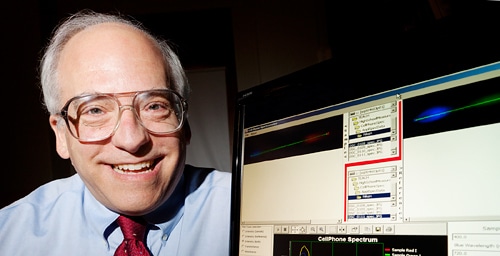University of Illinois chemistry professor Alexander Scheeline wants to see high school students using their cell phones in the classroom. Not for sending text messages or surfing the Internet, God forbid, but as a chemical analytical device

University of Illinois chemistry professor Alexander Scheeline wants to see high school students using their cell phones in the classroom. Not for sending text messages or surfing the Internet, God forbid, but as a chemical analytical device.
The professor developed a method for making a spectrometer, a basic and important chemical instrument, from cheap and basic means and a digital camera. Spectrophotometry (Wikipedia entry, Spectrophotometry) is one of the most common means of identifying and quantifying various substances both in the physical sciences and in the biological and chemical sciences. "If we want to measure the amount of protein in meat, or the amount of water in grains, or the iron in blood, we do it using spectrophotometry," explains the researcher.
Many schools have a limited budget for equipment and supplies, so spectrometers become too expensive for high school science classrooms. Even when the device is available, the students have difficulty understanding the principles of analytical chemistry at its core because most of them are closed boxes - the students simply insert the appropriate samples into the device and receive numerical values as an output, and this without giving their opinion about the chemical process being used. "Science means using your senses to understand things - it's just that technology today is so advanced that everything is unknown to us," said the researcher. "The student gets the impression that the measurement is something that takes place inside a box that is inaccessible and incomprehensible to him - and is within the realm of understanding of an expert engineer only," adds the chief researcher. "This is not what we want them to learn - in order for the scientific idea to be properly understood, they have to build the device themselves."
In light of this, the researcher asked to build a basic spectrometer that would not only be simple and cheap but also transparent so that the students could see its actual operation and play with its components, an activity that would encourage the students' thinking and problem-solving skills. The device also does not have to be the most accurate or sensitive device - in fact, the researcher hopes, that precisely the obvious shortcomings of the device will encourage the students to understand the operation and limitations of the device.
In a spectrometer, white light is passed through a sample solution. The solution absorbs certain wavelengths of this white light. After that, a diffraction grating splits the light into its color spectrum like a prism (or a rainbow). Analysis of the resulting spectrum allows chemists to learn about the properties of the sample.
As the light source, the researcher used a single light emitting diode (LED) powered by a 3 volt battery, the kind used in car key fobs. The diffraction gratings and the tubes in which the solutions are given, can be bought from suitable scientific companies for a few cents. The system as a whole costs less than three dollars. The problematic component in the system is the light sensor, the photo-sensor, which captures the spectrum that is subsequently analyzed.
"Suddenly I had the brilliant idea of where to get it: a photo-sensor that everyone has today! "Almost everyone has a mobile phone, and almost all of these phones have a digital camera," explains the researcher. "I realized that if the image can be transferred into a computer, then all that separates you from building a cheap spectrophotometer is the software." To that end, the researchers wrote software that analyzes the spectra stored in JPEG image files and distributed it free online, along with its source code and instructions for building and using a cell phone-based spectrometer.
The researcher used his innovative system in several classrooms, and the students, even though they had no experience with any equipment, received the device with enthusiasm. The students also showed a growing interest in the various concepts of the system such as the degree of sensitivity of the sensor to the light in the room and its effect on the ability to analyze the spectrum. The details of the construction of the spectrophotometer and its use were published in an article in the scientific journal Applied Spectroscopy. The researcher hopes that public publication of the software, the system and its components will cause other developers to further refine and upgrade the capabilities of this device.
"The potential lies in the fact that the field of analytical chemistry can be turned into a common field and not a topic that only scientists are interested in," explains the researcher.

4 תגובות
I love you
The man saw Star Trek and wants to apply
Adhering to technology that is still classified by governments
Interesting article
Question: Is it possible to perform spectrometry to monitor air pollution, say, of Ayalon at 8:00 in the morning?
Follow-up question (this is assuming that the answer to the first question is positive) What should be the resolution of such an image to perform such an analysis?
Of course, there are no such teachers in Israel. And certainly not such students